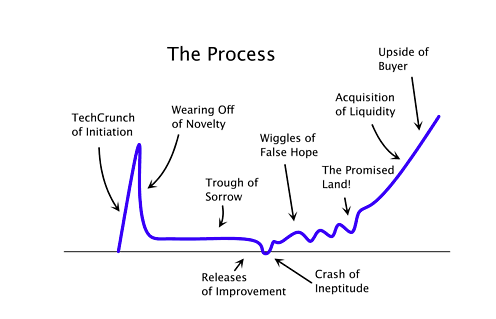

I have been getting some phone calls lately from founders and start-up friends that I have gotten to know over the years. They have been sharing stories of woe — their companies have seen a big dip (“Flat is the new up” has come back as a big term), they are having a hard time raising additional capital (VC investment was down 40-60% in 2023, depending on who you ask) and they are trying to find new markets for growth. In those conversations, I have regularly referred to the “Trough of Sorrows”. So, what is the Trough of Sorrows and why is it important?
YCombinator is one of the most well known start-up accelerators in the world. It has been part of the early days of some truly amazing and valuable companies — AirBnB, Instacart, Coinbase, Reddit, Twitch and many more. Those are the companies that get the headlines but they have been a part of over 2,200 companies over the years. And, while some companies have made it big, many more have “failed” and even more are still somewhere between success and failure.
YCombinator’s relatively high success rate is legendary and its low failure rate (some people estimate it at 40% when you consider current companies that are still in business but will likely fail) is also amazing when you compare it to industry averages (most people peg those averages between 40–90%).
But, there is one commonality between all of the Ycombinator companies regardless of their success or failure rate. This is something those companies share with nearly every start-up on earth. That commonality is something that Paul Graham, the leader of YCombinator, shared at a dinner in 2008 and it was immediately coined the “Trough of Sorrows”. Eventually, the concept made it on to a whiteboard and the drawing to describe it can be seen at the top of this post.
So, just what is the Trough of Sorrows?
NEARLY EVERY company will go through periods of time when they are one step away from the grave and one step away from taking another big leap towards success. Most people read the media and hear about the big successes and assume that company enjoyed a linear path from idea to massive success. But, this simply is almost never the case and most companies will not be able to escape the Trough of Sorrows.
The journey of a new company starts with a launch. A new company is formed and they then launch a new product or service (sadly, many companies that form never make it to the launch phase). Post launch, some companies will get an immediate surge of activity (while others won’t). This immediate surge of activity is invigorating and exciting and start-ups believe the upward trajectory will continue.
But, at some point after this initial rise, the buzz wears off. Initial customers will go away. Employees will leave. The market will go soft. And, the novelty will wear off. Press won’t write about that company any more and nothing will seem to work. At that point, despair sets in. That point is called the Trough of Sorrows.
Nearly all companies reach that point. And, then those companies start trying new and additional things. Most of those things don’t work. Further despair sets in. And, there becomes a “Crash of ineptitude”. Start-up teams start to doubt themselves and further despair follows. Most companies give up at that point.
Those that remain resilient through this Trough continue to try things and test. Some of those things work…kind of. They show bits of success but then come crashing back down. This stage is called the “Wiggles of false hope.” This can go on for months or even years. Most of the companies that made it out of the Trough of Sorrows will give up as these wiggles of false hope add up. An even smaller number will keep going.
That smaller number keeps testing. They keep trying things. They keep targeting new markets, launching news products or services or trying to find something that will “stick”. Again, a smaller number of those companies will make it out of this but those that do just may find the “Promised land”. At the Promised land, that company all of a sudden looks like an “overnight success” (the team knows much better) and the pieces start clicking. After a period of things clicking, that company may be able to find an acquirer or an exit. And, then…the final stage is the next stage of value creation when that company is acquired or goes public.
Why It’s Important For Start-Ups To Talk About The Trough Of Sorrows
The Trough of Sorrows was first mentioned at a time when Techcrunch was massive. Getting featured in Techcrunch seemed like everybody’s target. Getting featured in Techcrunch because your company just raised a pile of money was even better. And, getting featured in Techcrunch because your company just got acquired was the top of the mountain. But, the thing that Techcrunch did was make everybody think that success was:
Inevitable: That if a company could just raise capital and get featured in Techcrunch, that everything would work out.
A straight line: That getting from step one to a big outcome was a straight line. That starting a company meant starting with a great idea and then just being good at marketing and sales and it would be a constant up and to the right curve.
Ultimately, this time did a massive disservice to companies, start-up teams, investors and the market in general. Techcrunch has done an amazing job in covering the ecosystem over the years but many readers forget that they only cover part of the story. Because, well…nearly everybody has to go through the Trough of Sorrows. And, when a company is in that Trough of Sorrows, those false narratives made (and still make) companies feel that they were alone. It made companies, teams, and their investors feel that they were inept or it wasn’t worth continuing to push forward. And, I believe that made more companies give up when they could have kept fighting. Ultimately, there is a time to say something isn’t going to work but there is also a time to keep fighting and testing and trying…and the only way to know the difference is to have a clear head. I believe that part of why YCombinator is comparatively successful goes well beyond the network and the skills they help provide their companies. I believe part of it is that when the companies that are part of YCombinator hit the Trough of Sorrows, they have a community surrounding them that shows them they aren’t alone. This encourages more of those companies to keep pushing and more of them break through to the Promised Land.
Why The Notion Of The Trough Of Sorrows Has Endured
When venture funding was flowing, the Trough of Sorrows was still a reality for many/most companies.
When the M&A market was red hot, the Trough of Sorrows was still a reality for many/most companies.
When the IPO market was on fire, the Trough of Sorrows was still a reality for many/most companies.
And, when one or many of the above are no longer true, the Trough of Sorrows…is, yep, still there for many/most companies.
This is because starting and growing new ventures is really dang hard. And, this is true when times are good and when times aren’t.
So, What Do You Do About It If You Are Running An Early Stage Company
Well, as I said, many/most will go through this Trough of Sorrows. And, so, if that’s the case, I believe that it’s a good idea to talk about it with your teams, your investors and other around you. I have made it a habit of this over the last bunch of years and have done so when times are good and when times are challenging. So, wherever you are in running your own company, I would suggest understanding this concept and sharing it. Strangely, it gives some extra comfort but also gives additional motivation to keep pushing forward with optimism, hope and energy.
Note About Forward-Looking Statements
As Legion Is A Regulation A+ Entity, It Is Important That We Point Out That The Above May Contain Forward-Looking Statements And Information Relating To, Among Other Things, Legion Works, Inc., Its Business Plan And Strategy, And Its Industry. These Forward-Looking Statements Are Based On The Beliefs Of, Assumptions Made By, And Information Currently Available To The Company’s Management. When Used, The Words “Estimate,” “Project,” “Believe,” “Anticipate,” “Intend,” “Expect” And Similar Expressions Are Intended To Identify Forward-Looking Statements, Which Constitute Forward-Looking Statements. These Statements Reflect Management’s Current Views With Respect To Future Events And Are Subject To Risks And Uncertainties That Could Cause Legion Works, Inc.’s Actual Results To Differ Materially From Those Contained In The Forward-Looking Statements. Investors Are Cautioned Not To Place Undue Reliance On These Forward-Looking Statements, Which Speak Only As Of The Date On Which They Are Made. Legion Works, Inc. Does Not Undertake Any Obligation To Revise Or Update These Forward-Looking Statements To Reflect Events Or Circumstances After Such Date Or To Reflect The Occurrence Of Unanticipated Events.


